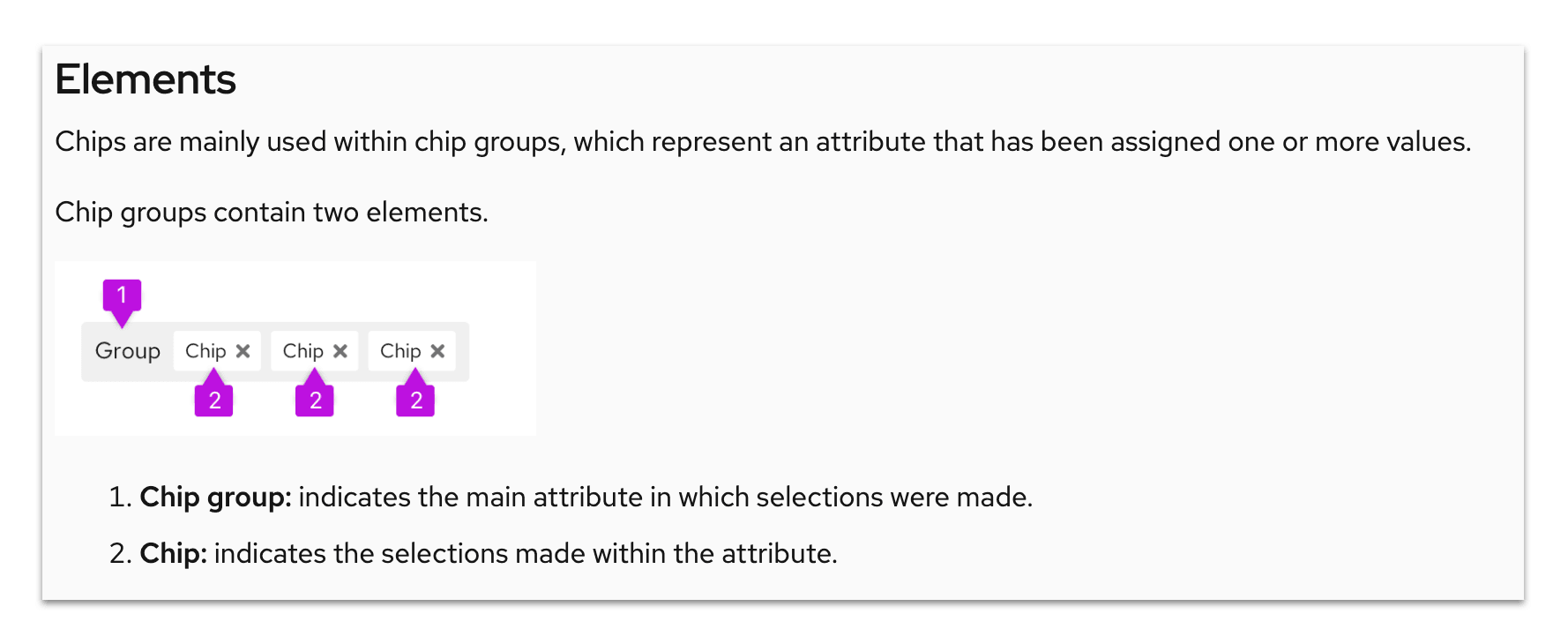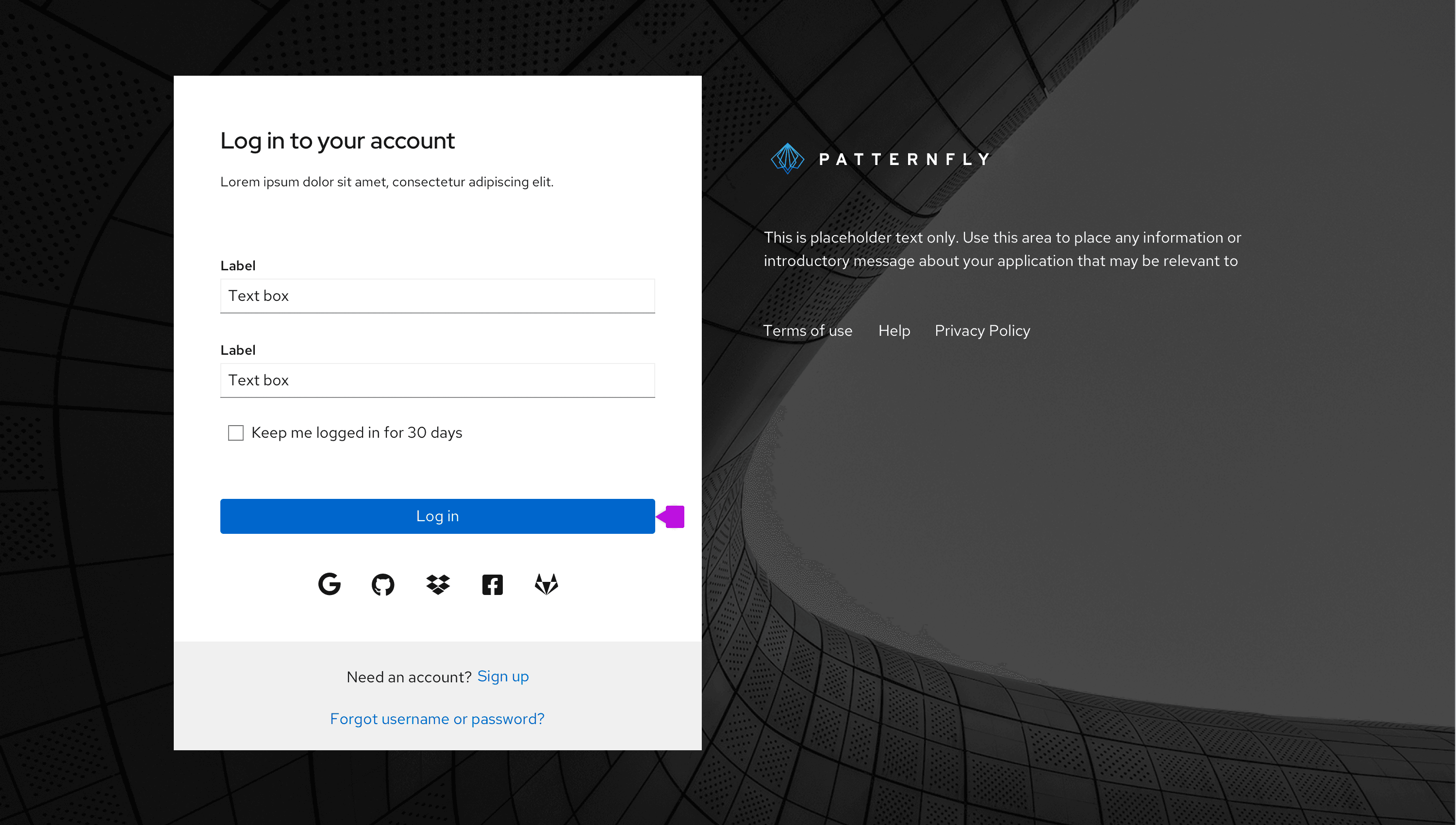This guide provides instructions for writing clear and consistent design documentation for PatternFly. PatternFly's design guidelines provide users with information regarding the design, usage, behavior, and more of PatternFly's elements and components.
To learn how to contribute design guidelines, see our contribution guide.
Design guidelines sections
When creating guidelines, refer to the following template to ensure that information is presented in a consistent order and within sections that are consistently named and structured. Sections may be omitted, but if they are present, you must use the specified section headings and heading levels.
Elements (H2)
Display an image of the component containing numbered annotation tags for each major part of the component's visual design. Include specific icons, headers, fields, symbols, and anything else included in the component's structure. Following the image, list all the parts you tagged, aligning with the number displayed in the respective annotation tag. In this list, provide a description of each one.
For example:

Usage (H2)
Explain how the component is used, when to use it, and why it should be used. Include explanations of problems it could help solve and address its advantages over similar components. Include images for visual examples.
Additional sub-sections to include:
When to use (H3)
When not to use (H3)
When to use X vs. Y (H3)
Examples of incorrect usage (H3)
Behavior (H2)
Explain how the component functions and break down how its elements interact with each other to achieve its purpose. It may be helpful to include additional images or animations to demonstrate how the component works.
Variations (H2)
Showcase different forms of your component and include explanations indicating when to use each one.
Additional sub-sections to include:
When to use X variation vs. when to use Y variation (H3)
Spacing (H2)
Introduce spacing requirements for components and their content. For more information regarding proper spacing, refer to our spacing guidelines.
Placement (H2)
Provide details on where components should be located in a UI and in relation to other components.
Content considerations (H2)
Showcase the different content that could be included within your component. Here is where you can also give additional tips and tricks the user may want to know. Content guidance includes:
- Editorial guidelines for labeling and message text.
- Length restrictions and what to do when text overflows.
- Localization considerations.
Accessibility (H2)
Each component that has an accessibility tab should include the following sentence within this section:
"For information regarding accessibility, visit the [component name] accessibility tab."
Then, link the component's accessibility tab to the words "accessibility tab."
Formatting
The following best practices should inform the way that you format the content in your design documentation.
Capitalization
Our capitalization style guidelines outline best practices for capitalization across PatternFly.
Always write headings in sentence case. Write component names in lowercase.
For example, "Usage guidelines for card views"
Bolds and italics
Bold component names when you first introduce them.
For example, "A card is a square or rectangle container of related information."
Italicize words for emphasis, but do so sparingly.
Lists
Lists help organize lengthy, complex content into shorter, scannable sections. Use lists to introduce use cases, exceptions, and procedures.
When building lists, follow these best practices:
- Use bullets by default. Only use numbers if the order of items is important, like in a callout list.
- Introduce your list with a clause or phrase that describes the information it shares.
- Start each item with a capital letter.
- End list items with a period if they're sentences, or if they form a full sentence when combined with the clause/phrase that introduces the list.
- Maintain parallel structure. Start every list item with the same part of speech. (For example, each item of this list starts with a verb.)
Images
Design documentation includes images to contextualize elements in a UI and demonstrate them in action. All images should include alt text for accessibility.
Annotations
Annotations highlight specific areas in an image. Follow these best practices when using annotations:
Use numbered callouts to call out multiple areas in your image, then use a corresponding numbered list to explain each one. For example:

1. Items in view: Allows the user to select the item count (number of listed items) per page, as seen in full pagination
2. Compact pager: Supplies the user with page-back and page-next controls only
Avoid using a callout to highlight a single item, unless you're pointing out a small part of a large view, or the item isn't clearly shown in your image. Use a blank, unnumbered callout to mark the area, then bold it in your explanation. For example:

Always write your login button as two words: "Log in."
Style, voice, and tone
PatternFly's documentation is friendly and instructional. Learn more about voice in our brand voice and tone section.
When writing design guidelines, use:
- Present tense.
- Second-person point of view ("you").
- Active voice, unless you're using passive voice for emphasis.
- Direct language and sentence structure.
- Full words to introduce examples, instead of their abbreviations ("for example" instead of "e.g."), as seen on our terms list.
- Descriptive language instead of directional language (up, down, left, right) to refer to elements in your document.
- Descriptive hyperlinks (not "click here").
If you're linking to other PatternFly pages, use relative URLs instead of full URLs.
Relative URL: /components/tooltip/design-guidelines
Full URL: https://www.patternfly.org/v4/components/tooltip/design-guidelines
View source on GitHub

